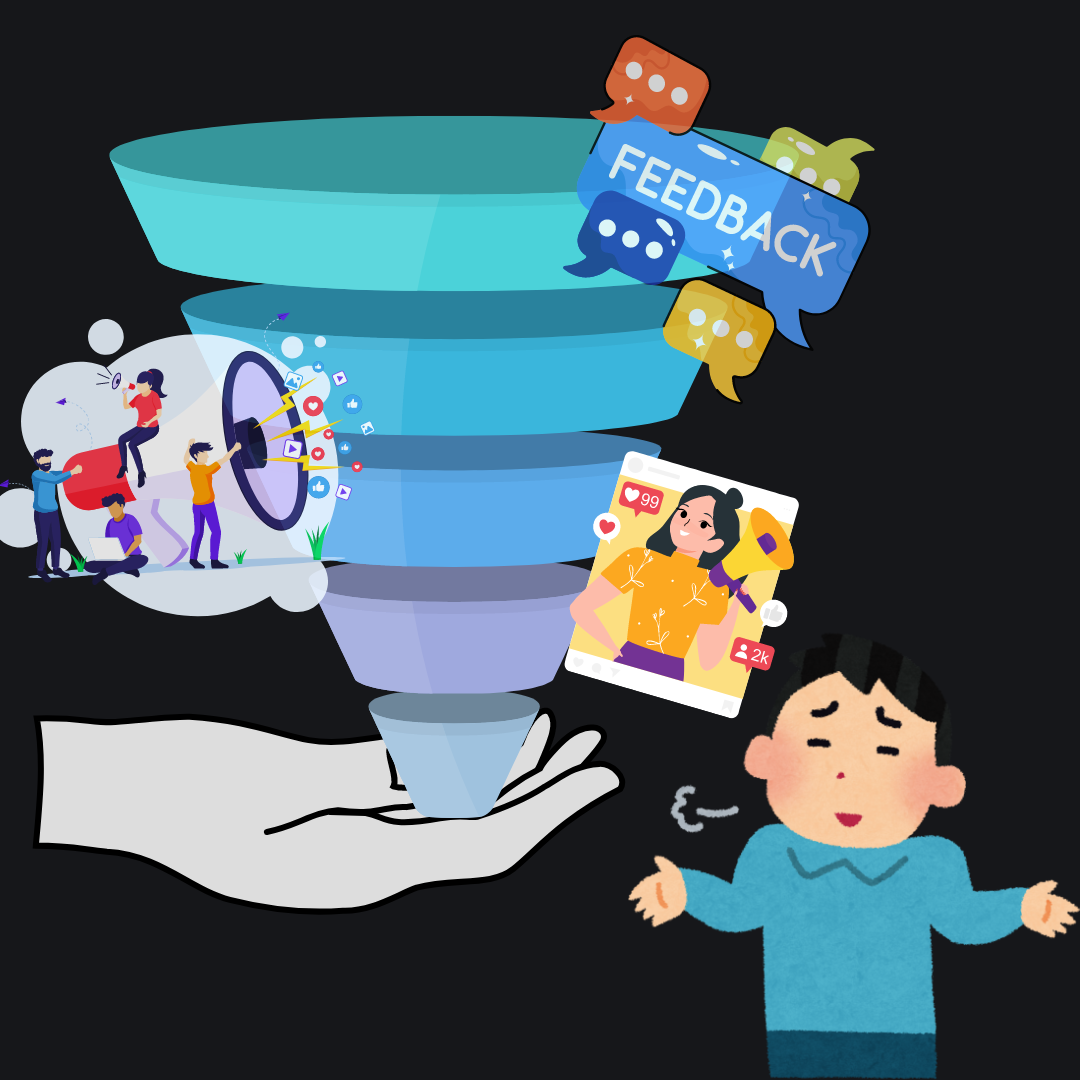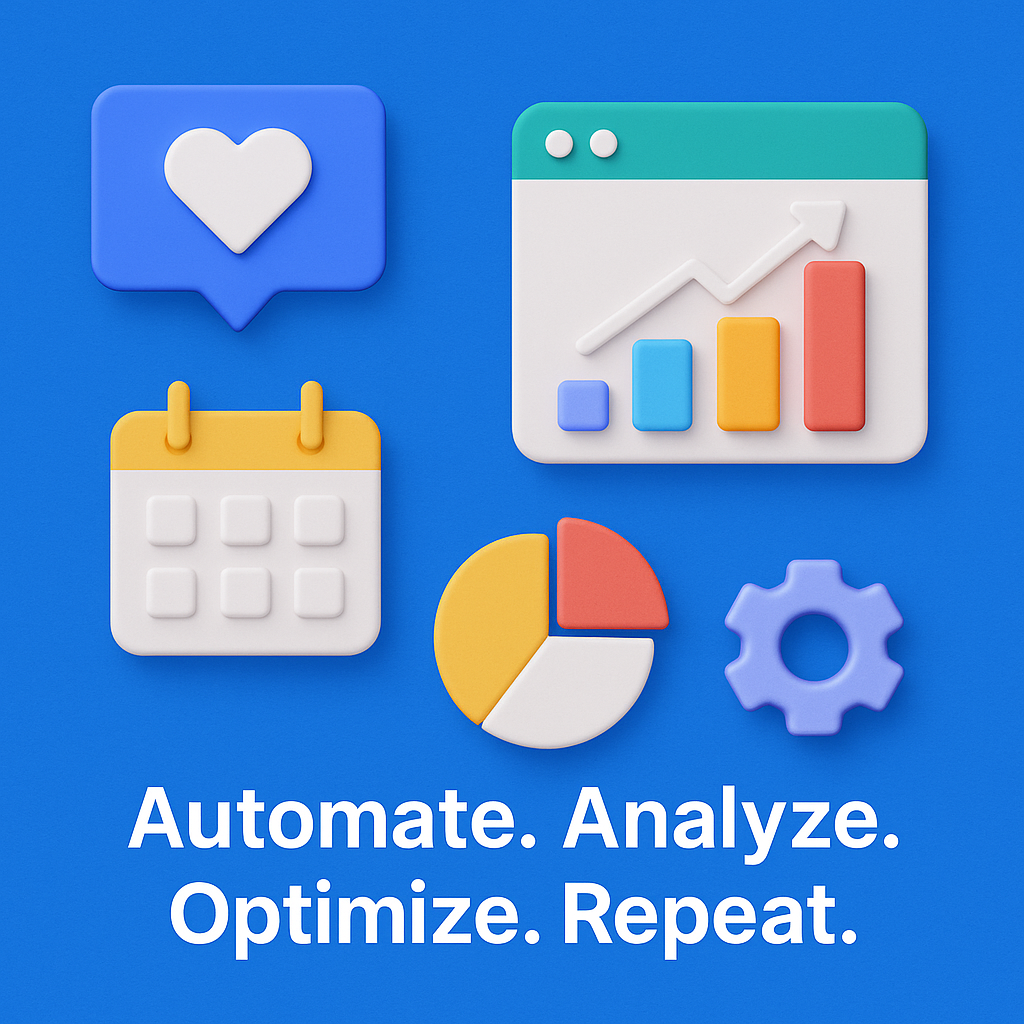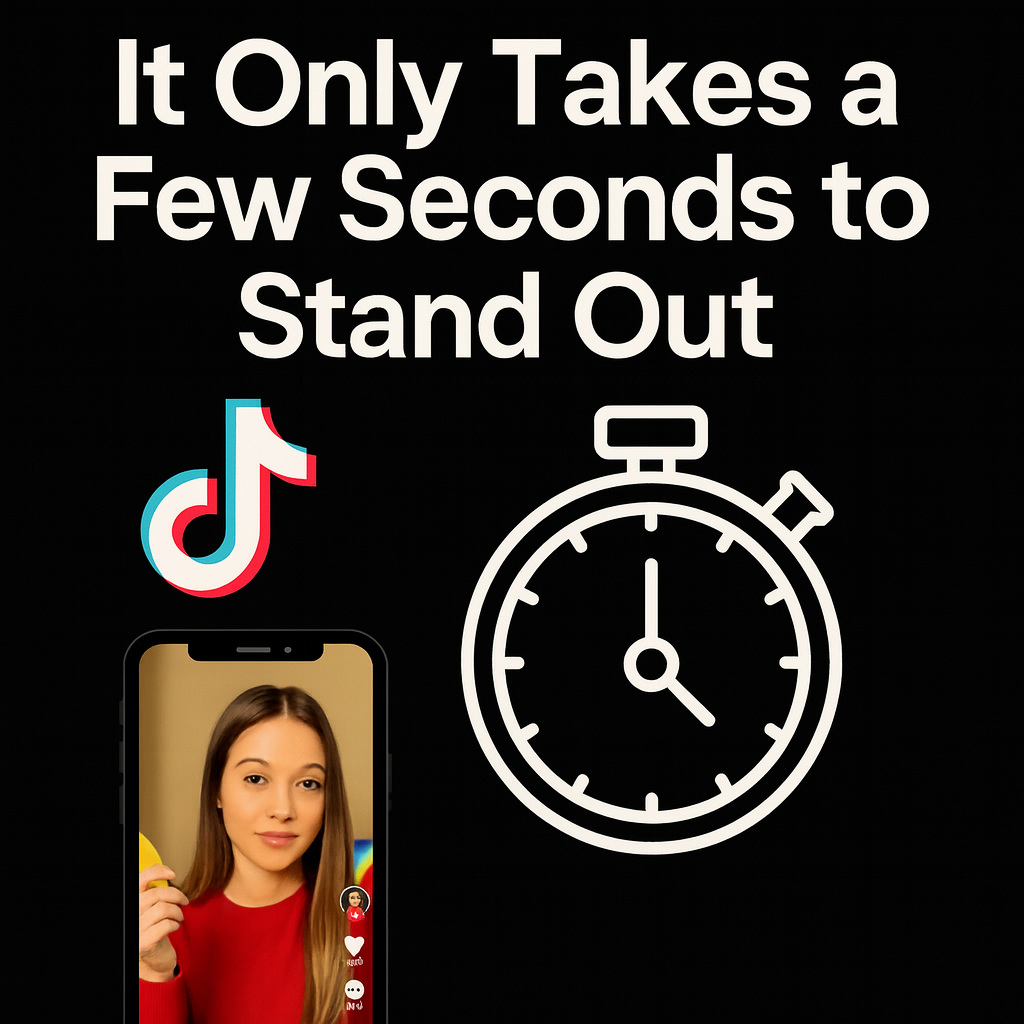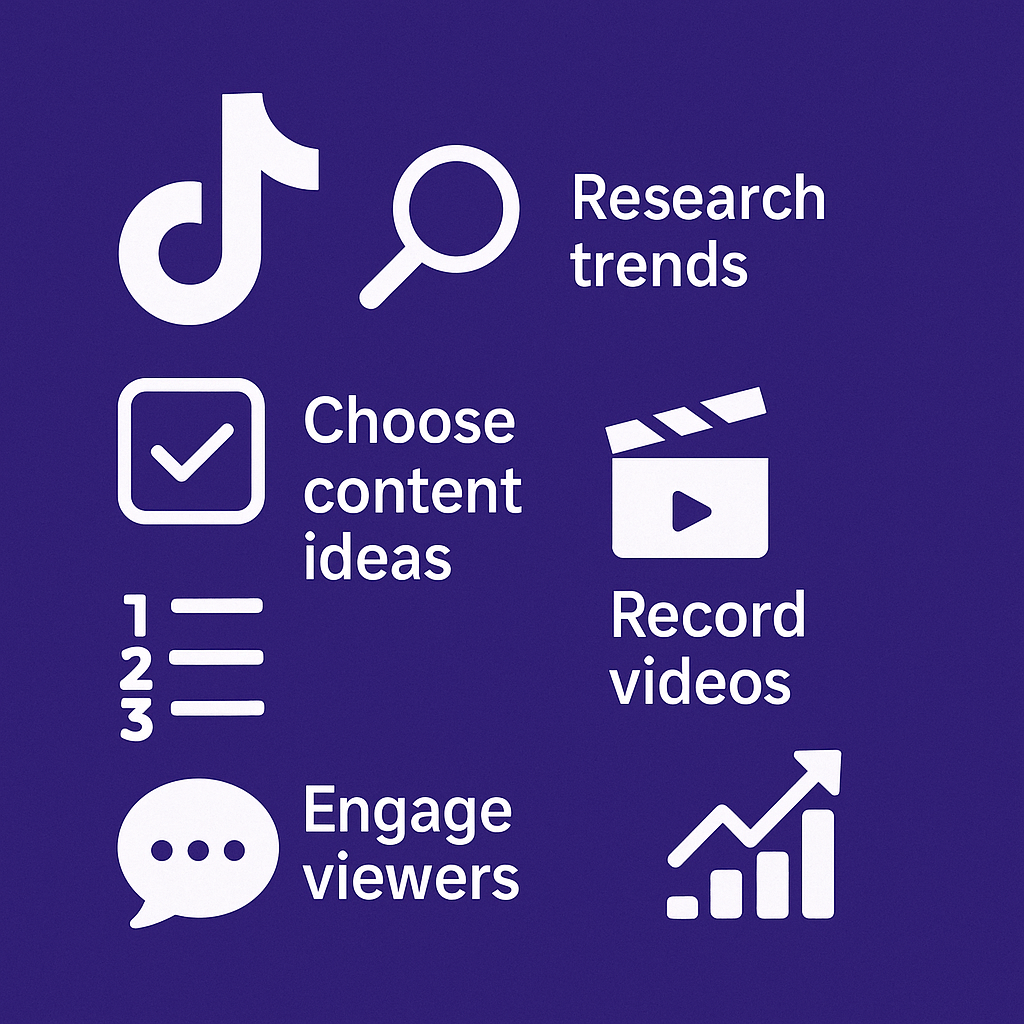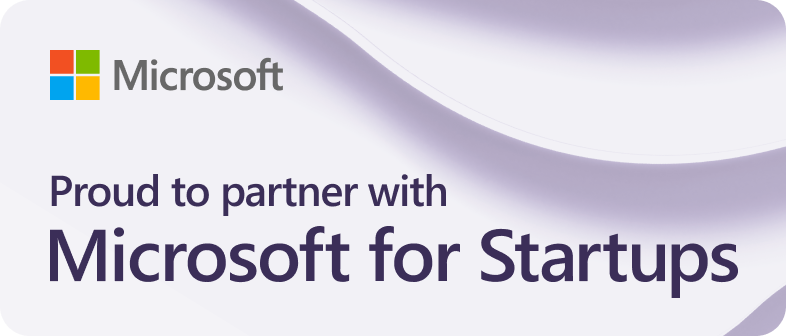Are you silently losing customers because you’re not listening to what they’re telling you?
Feedback at every stage of marketing funnel isn’t just a nice-to-have—it’s the lifeblood of your business’s growth.
Yet, many small business owners overlook this critical component, focusing solely on pushing their products and services forward without ever stopping to ask, “What do my customers think?”
Imagine crafting the perfect marketing campaign, only to watch it fall flat because you missed the mark on what your audience wants.
That’s what happens when feedback is ignored!
Every stage of marketing funnel, from awareness to retention, relies on understanding your customers’ needs, preferences, and pain points. Ignoring feedback is like flying blind—it’s only a matter of time before you crash.
In this article, we’ll reveal why collecting feedback at every stage of marketing funnel is essential to your success.
We’ll break down how feedback can transform each phase of your funnel and discuss how you can gather insights through key channels like email, social media, and your website.
Ready to stop guessing and start growing? Let’s dive in.
Understanding Stage of Marketing Funnel
To grasp the full impact of feedback on your business, it’s essential to understand the marketing funnel—a model that outlines the stages a potential customer goes through, from the moment they first hear about your brand to becoming a loyal customer.
Do you struggle with managing multiple social media platforms for your brand's presence?
The Sociosight app can help you simplify the process and save you time. With Sociosight, you can publish, schedule, and monitor posts and engage with your followers across multiple social media platforms, all from one dashboard.
Get started today with a free sign-up!
Register Now for Free

Each stage of marketing funnel represents a different phase in the customer journey, and understanding these stages is key to tailoring your marketing efforts effectively.
The marketing funnel typically consists of five main stages:
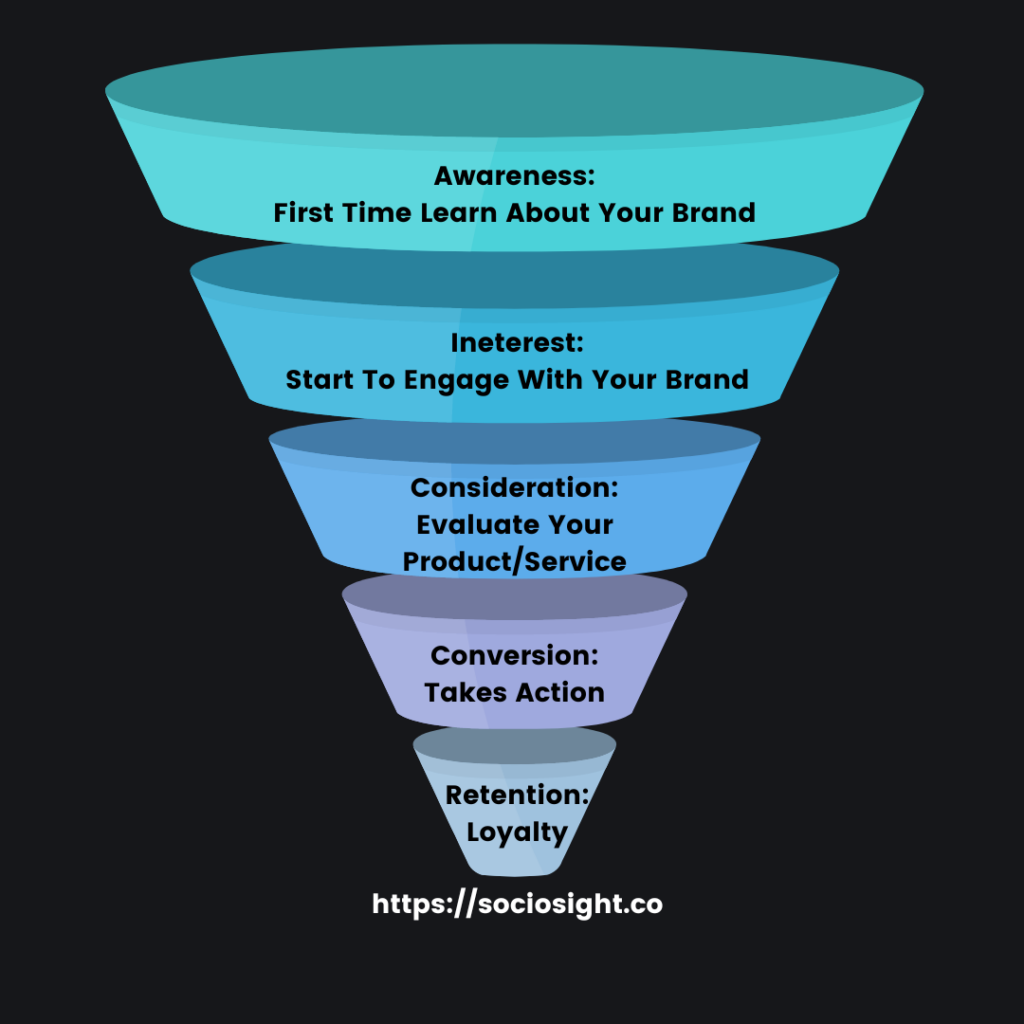
- Awareness: This is where your target audience or potential customers first learn about your brand. It’s the top of the funnel, where you cast a wide net to capture attention.
- Interest: At this stage, customers start to engage with your brand. They might visit your website, follow you on social media, or sign up for your newsletter, showing a genuine interest in what you offer.
- Consideration: Here, potential customers evaluate your products or services, comparing them with alternatives. This is the critical decision-making phase where they assess whether your offering meets their needs.
- Conversion: The moment of truth—this is when a potential customer takes action, whether that’s making a purchase, signing up for a service, or completing another key action.
- Retention: After the initial conversion, the focus shifts to keeping your customers satisfied, encouraging repeat business, and fostering long-term loyalty.
Why is it important to collect feedback at each of these stages?
Because feedback offers invaluable insights into what’s working and what’s not at every step of the customer journey.
Understanding customer perceptions and experiences at each stage of marketing funnel allows you to make informed adjustments, leading to better engagement, higher conversion rates, and stronger customer loyalty.
Without feedback, you’re left guessing, which can lead to missed opportunities and ineffective strategies.
In the next sections, we’ll explore how feedback can be leveraged at each stage of marketing funnel and how different marketing channels can be used to collect it.
How to Leverage Feedback at Each Stage of Marketing Funnel
Table of Contents
Feedback in the Awareness Stage
The awareness stage of your marketing funnel, is where potential customers first discover your brand. This is the stage where you aim to capture attention and make a memorable first impression.
Digital marketing channels like social media, online ads, and content marketing play a critical role in driving awareness.
But how can you tell if your efforts are working? This is where feedback becomes invaluable.
Why Feedback Matters in the Awareness Stage:
At this early stage, feedback helps you understand if your messaging is resonating with your target audience and whether your brand is reaching the right people.
Are your ads grabbing attention? Is your social media content engaging enough to spark curiosity? Gathering feedback at this point can reveal if your efforts are hitting the mark or need adjustment.
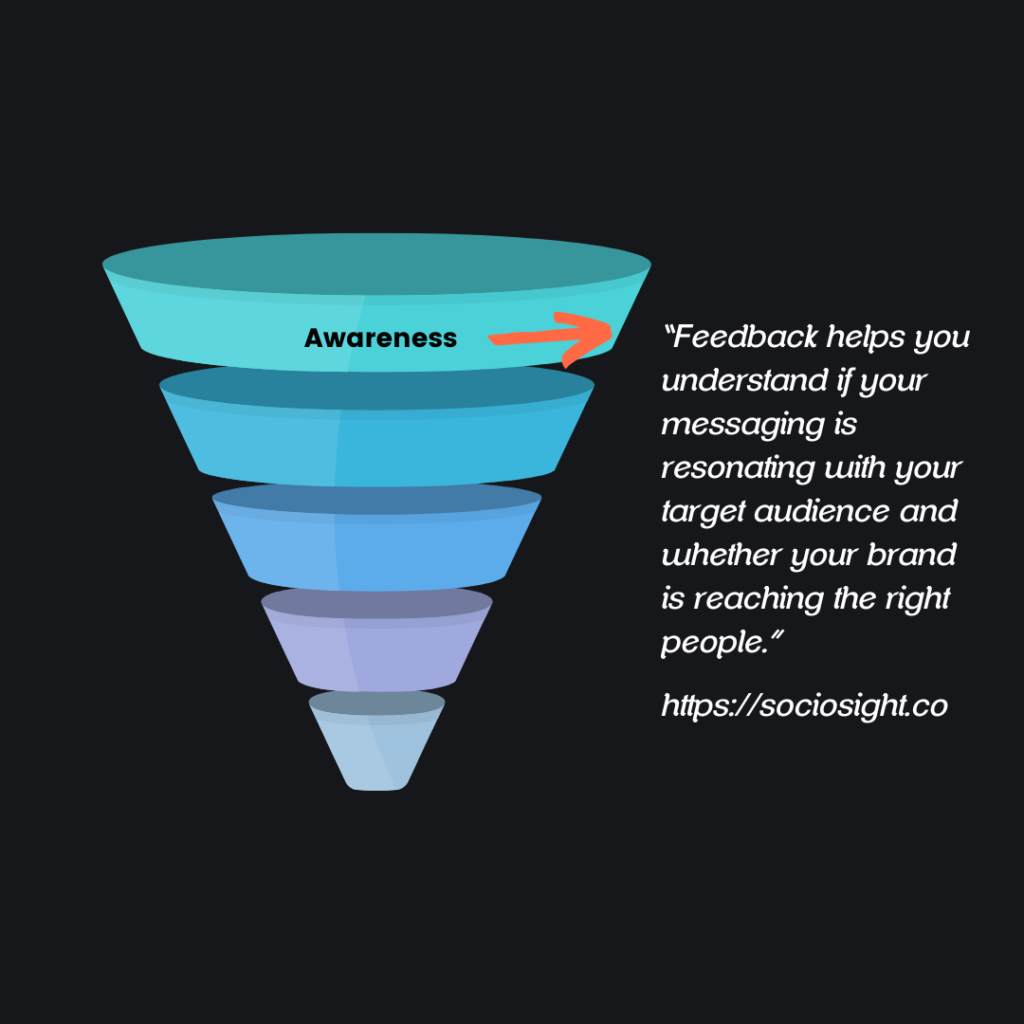
How to Collect Feedback:
- Social Media Engagement: Use engagement metrics like likes, shares, and comments as indirect forms of feedback. Additionally, create polls and ask direct questions in your social media posts to gather real-time input.
- Ad Performance Metrics: Track ad metrics such as click-through rates (CTR) and impressions. Low engagement could indicate that your messaging needs tweaking.
- Surveys and Polls: Deploy short, non-intrusive surveys to visitors who land on your website or social media pages. Ask them what caught their attention and what they would like to see more of.
Bonus Tip:
For businesses managing multiple social media accounts, tools like Sociosight, an all-in-one social media management software, can help you track and analyze social media feedback efficiently. Sociosight offers insights into engagement, audience demographics, and the best times to post, ensuring that your awareness efforts are optimized for success.
Feedback in the Interest Stage
The interest stage is where potential customers move from mere awareness of your brand to actively engaging with it.
They might visit your website, sign up for your newsletter, or follow you on social media, signaling that they’re interested in learning more about what you offer.
This stage of marketing funnel is critical because it’s where you start to build a relationship with your audience, making feedback essential for guiding your next steps.
Why Feedback Matters in the Interest Stage:
In the interest stage, feedback helps you understand what aspects of your brand or offerings are capturing your audience’s attention and where there might be gaps in their understanding or interest.
Are they finding the information they need? Is your content meeting their expectations? Feedback at this stage can reveal what’s working well and what might be turning potential customers away.
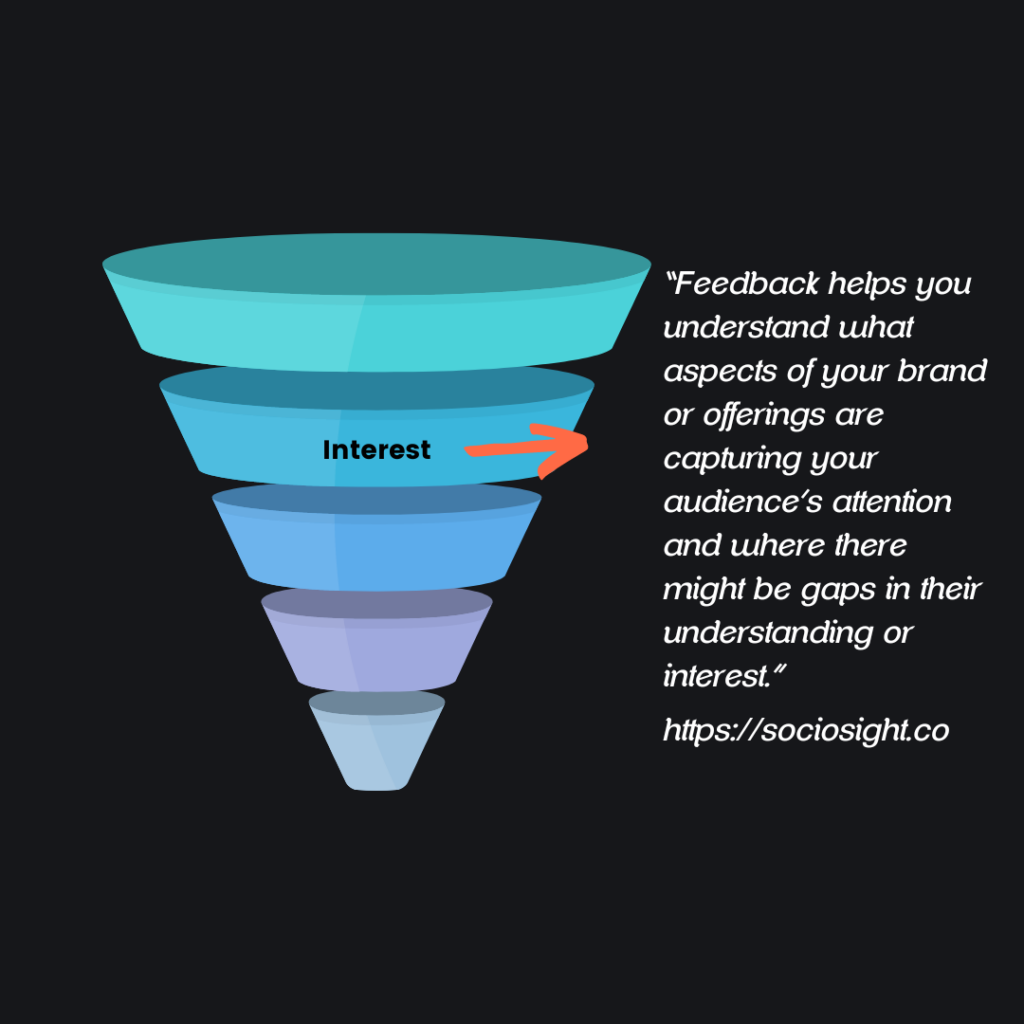
How to Collect Feedback:
- Email Engagement: Monitor open rates, click-through rates, and responses to email campaigns. Follow up with a short survey asking subscribers about their interests and what type of content they would like to receive.
- Website Analytics: Use tools like Google Analytics to track user behavior on your website. Look at metrics such as time spent on pages, bounce rates, and which pages are most visited. Complement this data with feedback forms that ask visitors what they were looking for and if they found it.
- Interactive Content: Consider using quizzes, polls, or interactive tools on your website or social media channels to engage users and gather feedback on their preferences and needs.
Bonus Tip:
Integrating feedback collected during the interest stage with your content strategy can significantly enhance your audience’s experience. Tools like Sociosight can streamline the process by analyzing social media interactions and helping you tailor your content to match your audience’s interests, ensuring that you’re nurturing their interest effectively.
Feedback in the Consideration Stage
The consideration stage of marketing funnel is where potential customers weigh their options and evaluate whether your product or service meets their needs better than the alternatives.
This is a critical decision-making phase; understanding how customers perceive your offering compared to your competitors can make all the difference.
Feedback at this stage of marketing funnel helps you fine-tune your messaging, address concerns, and highlight your unique value propositions.
Why Feedback Matters in the Consideration Stage:
At the consideration stage, feedback provides insights into what potential customers like about your product or service, what they find confusing, and what might be causing hesitation.
Are they concerned about price, features, or something else? This feedback is essential for overcoming objections and convincing prospects that your offering is the right choice.
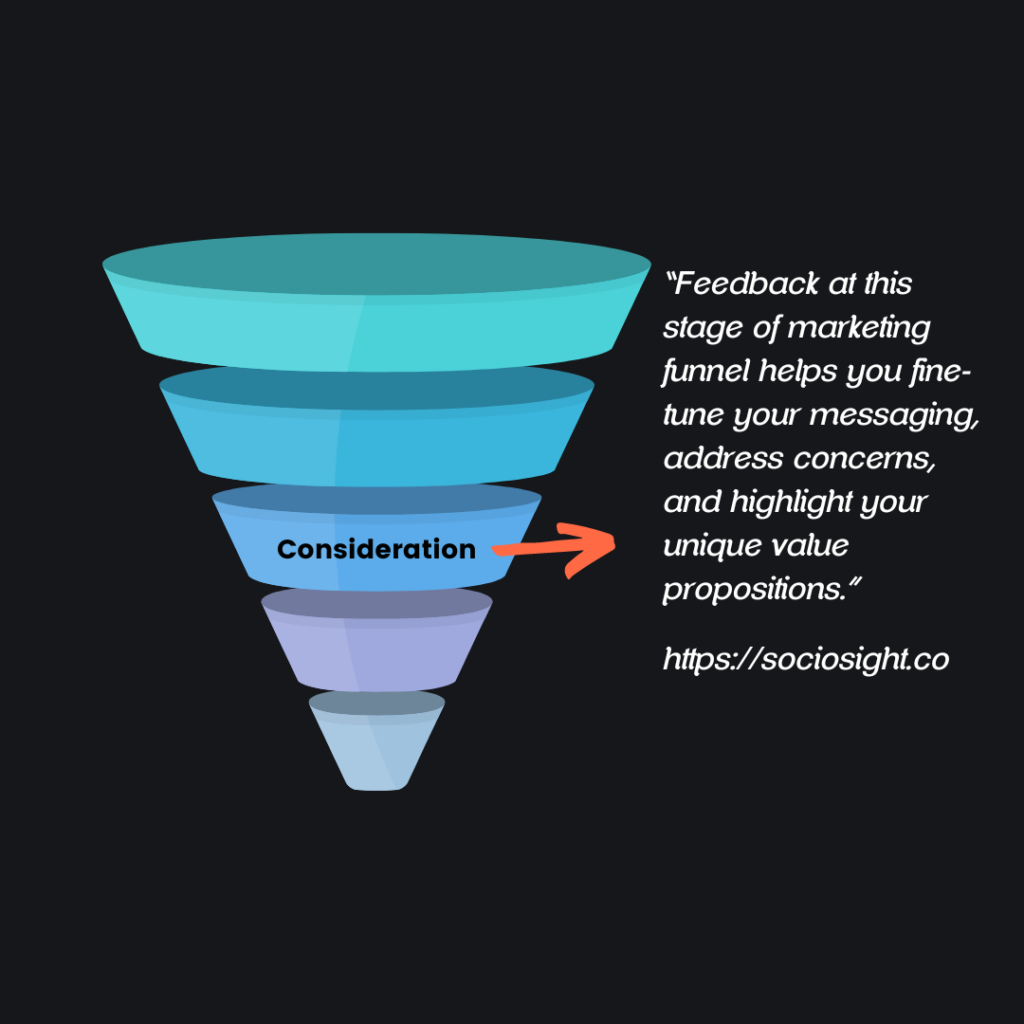
How to Collect Feedback:
- Product Demos and Trials: If you offer product demos or free trials, follow up with participants to ask what they liked, what didn’t work for them, and what could be improved. This helps you refine your offerings and address any issues preventing conversion.
- Social Media Polls and Q&A Sessions: Utilize Instagram Stories, Twitter polls, or LinkedIn polls to ask your audience specific questions about what they look for when choosing a product or service like yours. Host live Q&A sessions on platforms like Facebook Live or Instagram Live to directly address potential customers’ questions and concerns.
- Customer Review Requests: Encourage existing customers to leave reviews on platforms like Google My Business or Yelp. Analyze these reviews to identify strengths and weaknesses that might influence others in the consideration stage.
- Competitor Analysis Surveys: Send targeted surveys asking potential customers to compare your product with competitors. Focus on perceived value, feature preferences, or customer service experiences to understand what influences their decision-making process.
- Website Feedback Tools: Implement on-page feedback widgets on key pages of your website, such as product comparison pages or FAQ sections. After users engage with comparison tools, send a follow-up email or display a quick survey to gather feedback on their decision-making experience.
- Social Listening Tools: Use social listening tools to monitor conversations about your brand and competitors on social media. Identify recurring themes or concerns and address them in your messaging or content.
- Webinars and Follow-Up: Host educational webinars that dive deeper into your product or service features. After the webinar, send out a feedback form to understand what resonated most with attendees and what questions they still have.
- Interactive Content: Create calculators, quizzes, or configurators that help potential customers understand how your product meets their needs. Follow up with a feedback form asking if the tool was helpful and if there are any other features or comparisons they’d like to see.
Bonus Tip:
By utilizing a tool like Sociosight, you can monitor social media conversations and mentions of your brand versus competitors in its (coming soon) Social Listening tool. This helps you understand how your brand is perceived in the market and allows you to adjust your messaging to better align with customer expectations and needs during the consideration stage.
Feedback in the Conversion Stage
The conversion stage is the moment of truth—where a potential customer decides to take action, whether it’s making a purchase, signing up for a service, or completing another key action. At this stage, every detail matters, from the ease of the checkout process to the clarity of your call-to-action. Feedback during the conversion stage is crucial for identifying and eliminating any friction points that could prevent a customer from completing their journey.
Why Feedback Matters in the Conversion Stage:
Feedback at the conversion stage helps you pinpoint any last-minute hesitations or obstacles that might prevent a potential customer from converting. Whether it’s confusion about pricing, a complicated checkout process, or unexpected costs, understanding these issues allows you to optimize the conversion experience and reduce drop-offs.
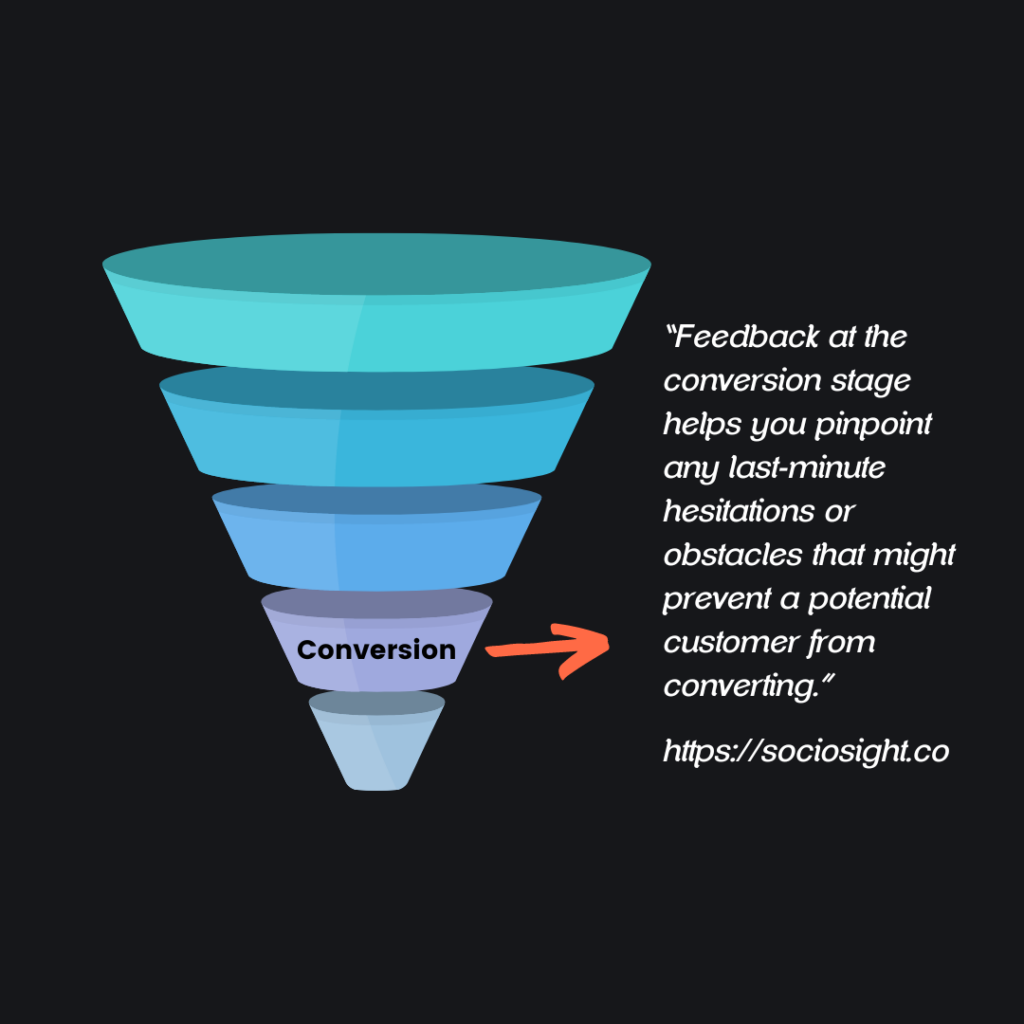
How to Collect Feedback:
- Post-Purchase Surveys: After a customer completes a purchase, send a brief survey asking about their experience. Questions can cover the ease of the checkout process, the clarity of information provided, and any challenges they faced.
- Abandoned Cart Follow-Ups: If a customer adds items to their cart but doesn’t complete the purchase, send an email asking why. Include a short survey to gather feedback on what stopped them from finalizing the transaction.
- Live Chat Transcripts: If you offer live chat support during the checkout process, review transcripts to identify common questions or concerns that arise. This can highlight areas where additional information or support might be needed.
- Exit-Intent Popups: If a user is about to leave your checkout page without completing the purchase, use exit-intent popups to ask what’s holding them back. Offer options like “Too expensive,” “Need more information,” or “Not ready to buy,” and include a free-text option for more detailed feedback.
- Conversion Analytics: Use tools like Google Analytics or your e-commerce platform’s analytics to track where users drop off during the conversion process. Combine this data with direct feedback to identify patterns and areas for improvement.
- Social Media Feedback: Monitor social media channels for any comments or discussions about your purchasing process. Customers often share their frustrations or positive experiences publicly, providing real-time insights into your conversion stage.
Bonus Tip:
Integrate feedback from the conversion stage of marketing funnel into your overall optimization strategy using a social media management platform like Sociosight. By tracking customer interactions and feedback across social media platforms, you can identify common barriers to conversion and address them proactively, ensuring a smoother path to purchase.
Feedback in the Retention Stage
The retention stage is where the focus shifts from acquiring new customers to keeping the ones you’ve already gained.
Retaining customers is not only more cost-effective than acquiring new ones, but also essential for building long-term brand loyalty and increasing customer lifetime value.
Feedback in this stage of marketing funnel is critical for understanding how well your product or service meets ongoing customer needs and what you can do to enhance their experience.
Why Feedback Matters in the Retention Stage:
Feedback during the retention stage helps you gauge customer satisfaction, identify areas for improvement, and discover opportunities to deepen customer relationships.
Understanding why customers stay with your brand—or why they might leave—allows you to make informed decisions that strengthen loyalty and encourage repeat business.
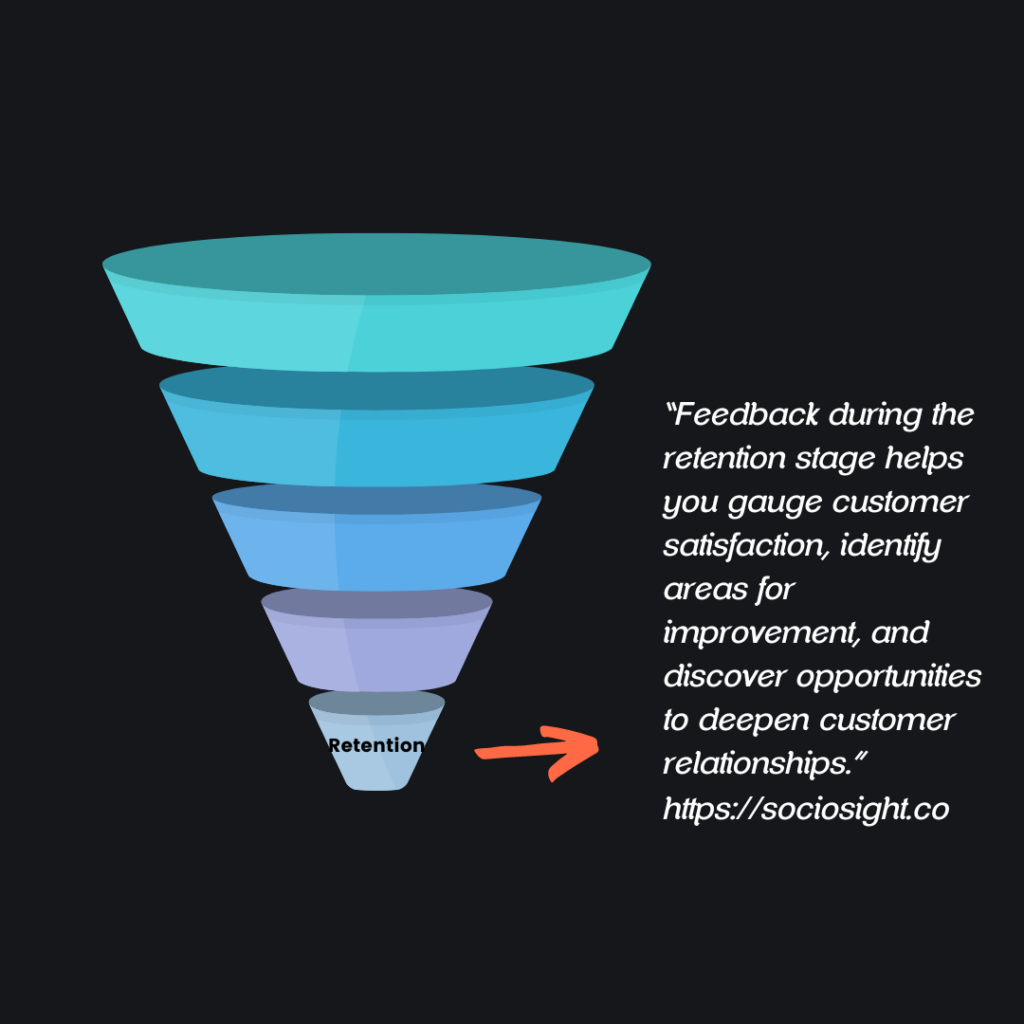
How to Collect Feedback:
- Customer Satisfaction Surveys (CSAT): Send regular CSAT surveys to assess how satisfied customers are with your product or service. These surveys can be triggered after key interactions, such as a purchase, a customer service experience, or the delivery of a product.
- Net Promoter Score (NPS): Use NPS surveys to measure customer loyalty by asking how likely customers are to recommend your brand to others. Follow up with additional questions to understand the reasons behind their score and what you can do to improve it.
- Loyalty Program Feedback: If you have a loyalty program, solicit feedback from participants to understand what they value most and what could be improved. This helps you optimize the program to better meet their needs and encourage continued engagement.
- Customer Support Feedback: After resolving a support issue, ask customers for feedback on their experience. Understanding how well your support team handles problems can highlight areas for training or process improvements that can boost retention.
- Churn Analysis: Reach out to customers who have stopped using your product or service to understand why they left. This feedback is invaluable for identifying common issues that lead to churn and finding ways to address them.
- Community Engagement: Engage with your customers on social media platforms, forums, or community groups. Encourage them to share their experiences and feedback, which can provide ongoing insights into how your brand is perceived and where improvements are needed.
Bonus Tip:
Utilize Sociosight to monitor and engage with your audience across social media platforms. Analyzing feedback from your customers allow you to identify trends in satisfaction or dissatisfaction and adjust your retention strategies accordingly, ensuring that your most loyal customers continue to feel valued and supported.
Integrating Feedback Across Marketing Channels
Collecting feedback is essential, but it’s only the first step.
To truly optimize every stage of marketing funnel, you need to integrate this feedback across all your marketing channels—email, website, ads, social media, and more.
Each channel plays a unique role in your overall strategy, and by weaving feedback into your approach, you can ensure that your messaging is consistent, relevant, and resonant at every touchpoint.
Why Integration Matters:
Feedback from different channels provides a holistic view of your customers’ experiences and expectations.
By combining insights from email campaigns, website interactions, social media conversations, and ad performance, you can create a unified strategy that addresses customer needs more effectively.
This integration allows you to refine your messaging, improve customer interactions, and ultimately, drive better results throughout your marketing funnel.
Using Sociosight for Social Media Feedback Management:
One of the most challenging aspects of feedback integration is managing multiple profiles across various social media platforms. This is where Sociosight comes in.
As an all-in-one social media management system, Sociosight allows you to seamlessly manage multiple profiles, track engagement, and analyze feedback across platforms like Facebook, Instagram, Twitter, and LinkedIn.
With Sociosight, you can:
- Monitor Conversations: Keep track of brand mentions (coming soon), comments, and direct messages (coming soon) across all your social media accounts, so you never miss valuable feedback.
- Analyze Engagement: Get detailed insights into how your audience is interacting with your content, helping you understand what resonates and what needs adjustment.
- Optimize Posting Schedules: Use historical data to determine the best times to post, ensuring your content reaches the maximum number of people.
- Respond Efficiently: Manage responses from a centralized dashboard, allowing you to engage with your audience promptly and effectively.
Conclusion:
Feedback is the lifeblood of a successful marketing strategy, but its power is only realized when it’s actively collected, thoughtfully integrated, and strategically applied across all stages of your marketing funnel.
From awareness to retention, each stage offers a unique opportunity to learn from your audience and refine your approach. Don’t let feedback be an afterthought—make it the foundation of your growth strategy.
Tools like Sociosight empower you to harness this feedback across your social media platforms, ensuring that your marketing efforts are not only reaching your audience but also resonating with them. So, sign up now to get access to Sociosight App forever with only a one-time payment of $95. Need more information about Sociosight? Chat with us now, or schedule a demo.




